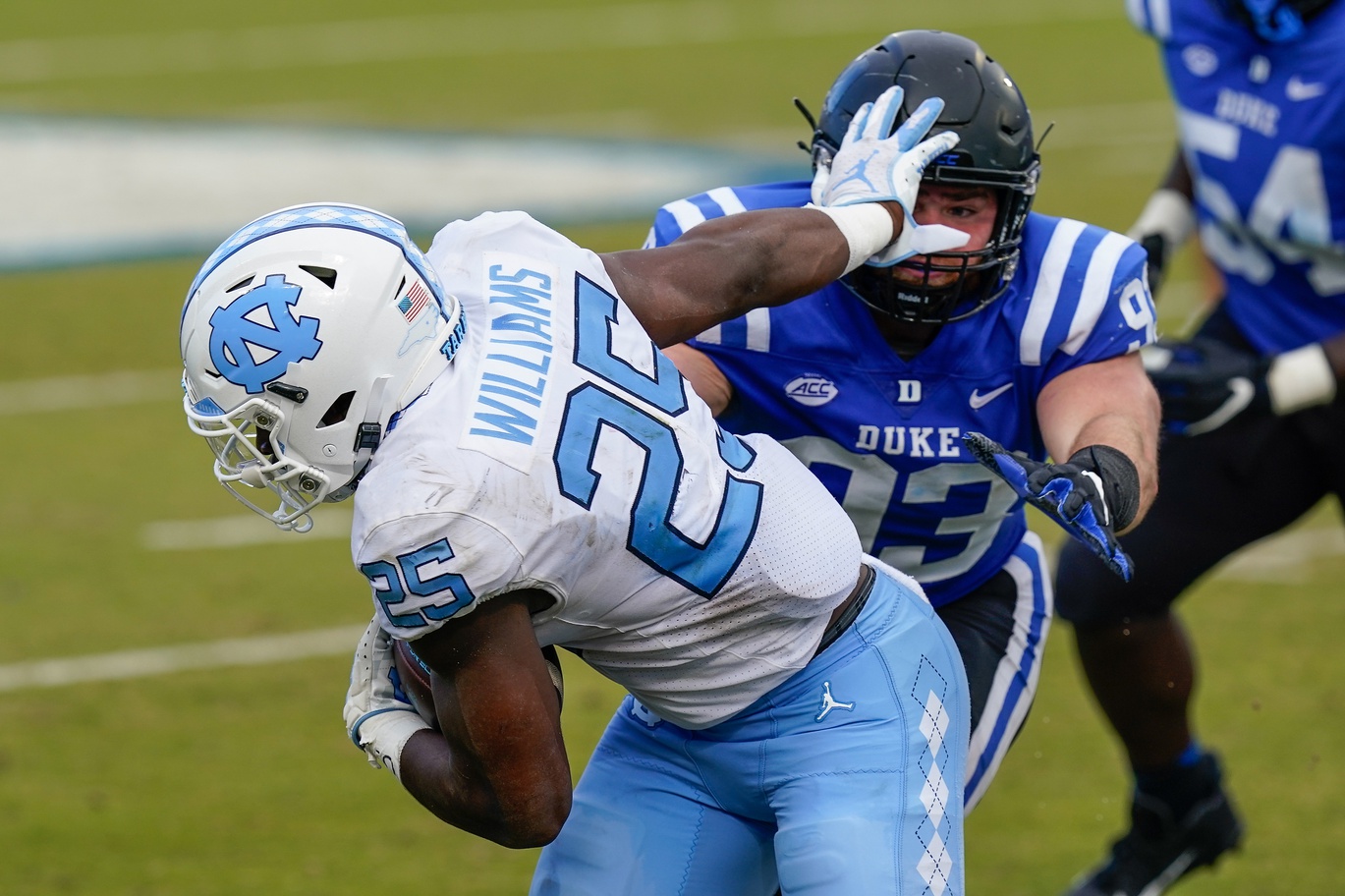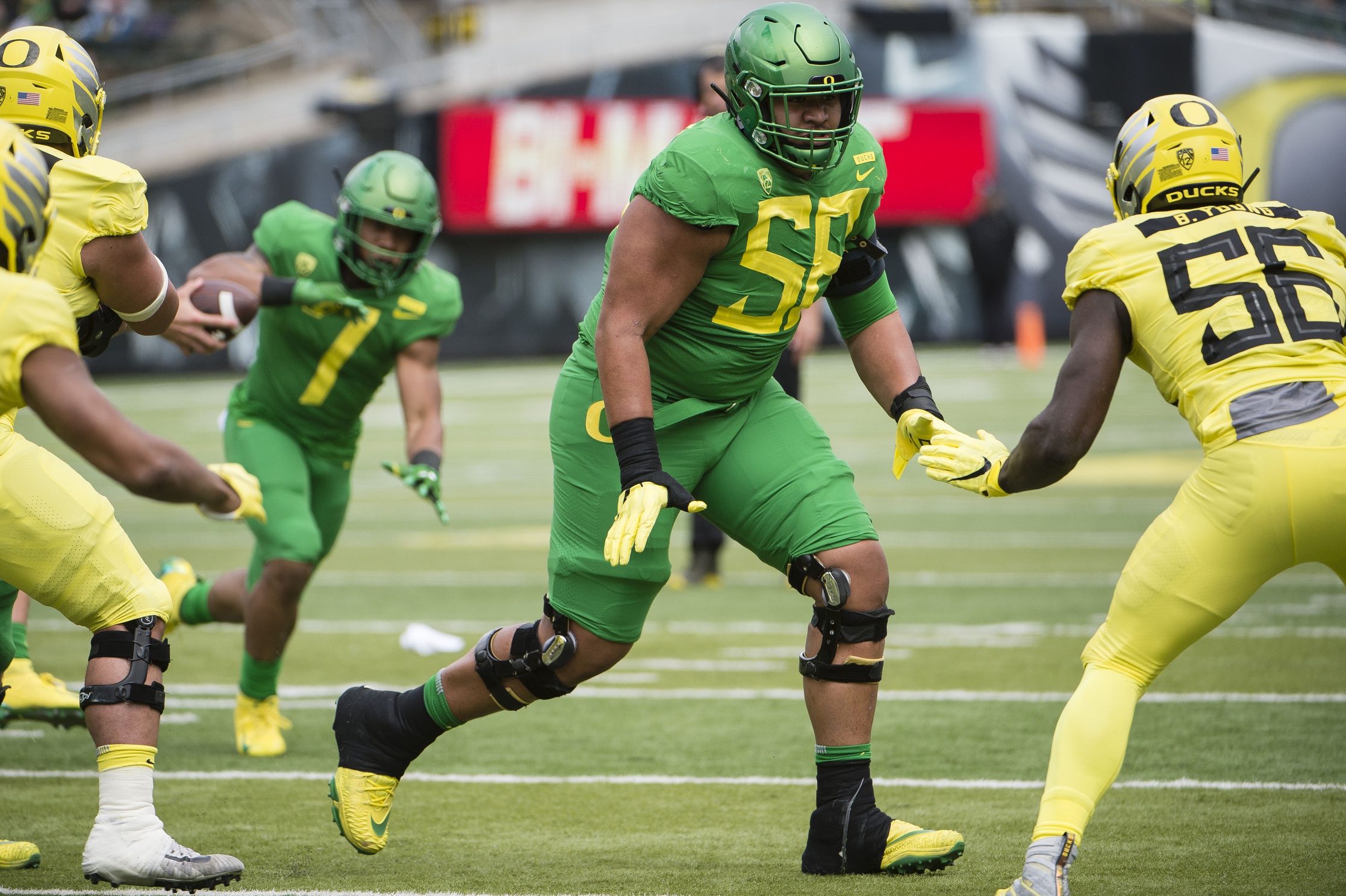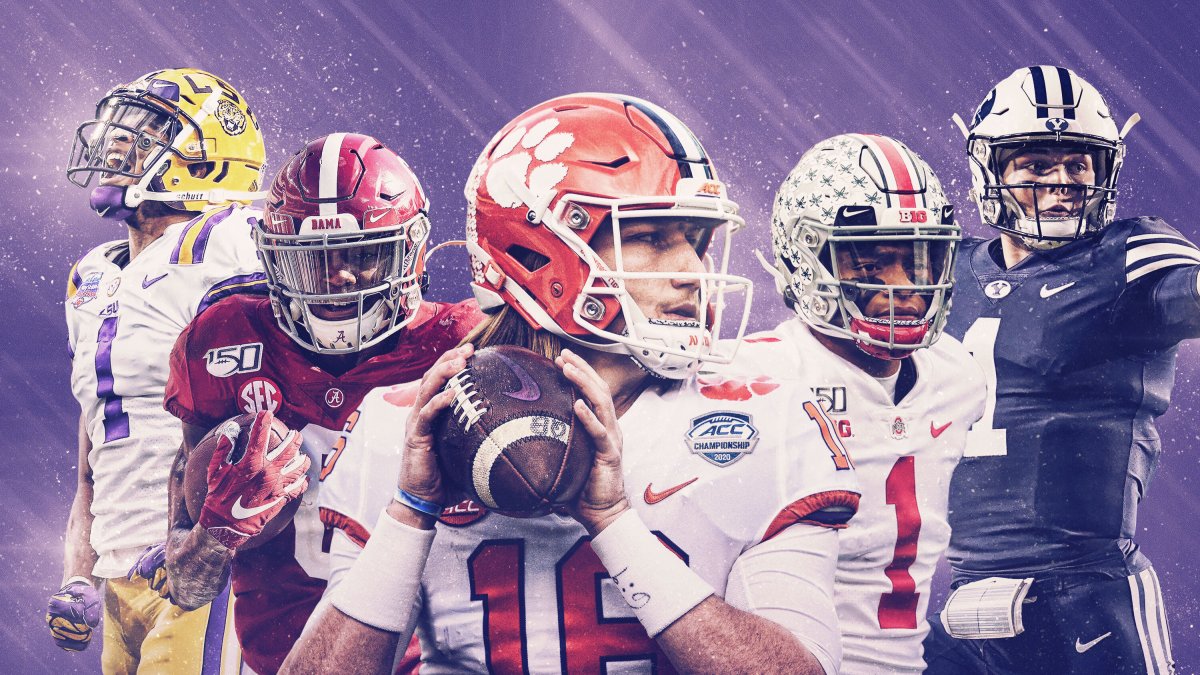Last April, we looked at the numbers that are most important when projecting players from college to the NFL. Prior to the 2020 season, we did the same for the 2021 draft class, and we now have more information for most players for a pre-draft update.
The depth of the PFF database has allowed us to isolate the most important numbers for each position group, adding context to the overall PFF grade. The PFF grade is a unique, production-based assessment of each player’s performance on every snap, and it is the foundation for our projection system. While the grade itself is valuable when standing on its own, it’s the construction of the grade and the surrounding context that adds the most predictive power. Each position has its own set of metrics that are more important when projecting college players to the next level, and each position has its own strengths and weaknesses when it comes to using data for projections.
Here’s a look at the key metrics and where the top players in the draft class stack up as we head into the 2021 NFL Draft.
QUARTERBACK
Stable Metrics:
-
- Passing grade from a clean pocket
- Passing grade on standard dropbacks (from within the pocket)
- Passing grade on first/second down
- Passing grade with no play action
- Passing grade on passes at/beyond the sticks
- Percentage of negatively graded throws
Unstable Metrics:
-
- Passing grade under pressure
- Passing grade from outside the pocket
- Passing grade on third/fourth down
- Passing grade with play action
- Percentage of positively graded throws
Draft Class Notes
-
- When compared to recent NFL prospects, Clemson’s Trevor Lawrence ranks above average in every stable metric. His only below-average unstable metric is a 27th-percentile passing grade when outside the pocket.
- Using the same dataset of recent NFL prospects, BYU’s Zach Wilson ranks above the 75th percentile in every stable metric other than a 73rd-percentile ranking with no play-action.
- Ohio State’s Justin Fields has exceptional grading in five key stable metrics, but it’s his 61st-percentile raking in avoiding negatively graded throws that brings him down with respect to recent NFL prospects.
- Alabama’s Mac Jones ranks above the 90th percentile in all stable metrics, including the all-important negatively graded plays column where he has the second-lowest rate when compared to recent NFL-caliber prospects.
RUNNING BACK
Stable Metrics:
-
- Rushing grade
- MT/ATT (missed tackles per attempt)
- YCo/ATT (yards after contact per attempt)
- Receiving grade
- MT/Reception (missed tackles per reception)
- Yards per route run
Unstable Metrics:
-
- Yards before contact/Rush
- Fumble%
- Breakaway%
- Team run-blocking grade (when player is the runner)
- Drop%
Draft Class Notes:
-
- UNC’s Javonte Williams has forced a missed tackle every 0.39 carries, No. 1 among recent NFL-caliber running backs.
- Clemson’s Travis Etienne has averaged 4.5 yards after contact per rush in his career, best in the draft class and No. 2 when compared to recent NFL-caliber prospects.
- Alabama’s Najee Harris has averaged 0.44 missed tackles per reception, best in the draft class.
- Memphis’ Kenneth Gainwell leads the class with 2.46 yards per route, third-best when compared to recent NFL-caliber prospects (behind Christian McCaffrey and Alvin Kamara).

WIDE RECEIVER
Stable Metrics:
-
- Receiving grade
- Receiving grade vs. single coverage
- Receiving grade vs. ZUT (zone, underneath, top)
- Separation% (all targets)
- Separation% vs. single coverage
- Yards per route run
- aDOT (average depth of target)
- YAC/Rec
Unstable Metrics:
-
- Drop rate
- Contested catch%
- Catchable targets
Draft Class Notes:
-
- Alabama’s De’Vonta Smith has the top receiving grade among recent NFL-caliber prospects, including the top grade when targeted in single coverage. He’s also seventh out of 144 qualifiers in YAC per reception at 9.1.
- LSU’s Ja’Marr Chase is right there with Smith in receiving grade, also topping any other recent NFL-caliber prospect. Chase ranks in just the 51st percentile in separation percentage vs. single coverage when compared to 78 recent NFL-caliber prospects.
- LSU’s Terrace Marshall ranks third in the draft class with a separation percentage of 77.5% when targeted in single coverage in 2020.
TIGHT END
Stable Metrics:
-
- Receiving grade
- Receiving grade vs. single coverage:
- Receiving grade vs. ZUT (zone, underneath, top)
- Separation% (all targets):
- Separation% vs. single coverage
- Yards per route run
- aDOT (average depth of target)
- YAC/Rec
- Run-blocking pos. grade %
Unstable Metrics:
-
- Drop rate
- Contested catch%
- Catchable targets
- Run-blocking neg. grade%
Draft Class Notes:
-
- Florida’s Kyle Pitts has the highest grade in the draft class on 113 targets against single coverage.
- Over the last two seasons, Miami’s Brevin Jordan leads the draft class in both separation percentage vs. single coverage (63.2%) and YAC/reception (9.2).
- Notre Dame’s Tommy Tremble has the highest percentage of positively graded run blocks in the draft class over the last two years, and he ranks seventh among NFL-caliber tight ends going back to 2014.
OFFENSIVE TACKLE
Stable Metrics:
-
- Pass-blocking grade
- Pass-blocking grade on true pass sets
- Pass-blocking grade with no play action
- Pass-blocking grade on 5-step, 7-step concepts
- Run blocking on gap runs
- Run blocking on zone runs
- Run blocking negatively graded play percentage
Unstable Metrics:
-
- Pass-blocking grade with play action
- Pass-blocking grade on 3-step concepts
- Pass-blocking grade vs. 3-man rush
- Sack% allowed
- Run-blocking positively graded play percentage
Draft Class Notes:
-
- When compared to recent NFL-caliber prospects, Oregon’s Penei Sewell ranks in the 87th percentile or better in every pass-blocking metric, and he’s in the 98th percentile in run blocking on zone runs. The big question is his 41st-percentile rank in negatively graded plays as a run-blocker.
- BYU’s Brady Christensen has the fourth-highest pass-blocking grade on true pass sets and the lowest percentage of negatively graded run blocks in the draft class over the last two seasons
- Virginia Tech’s Christian Darrisaw has the best run-blocking grade on zone runs among NFL-caliber tackles since 2014, but he ranks in the 41st percentile on true pass sets. His overall pass-blocking grade is aided by a 91st-percentile rank in pass-blocking grade on play-action and a 98th-percentile rank on three-step concepts, both unstable metrics.

INTERIOR OFFENSIVE LINE
Stable Metrics:
-
- Pass-blocking grade
- Pass-blocking grade on true pass sets
- Pass-blocking grade with no play action
- Pass-blocking grade on 5-step, 7-step concepts
- Run-blocking on gap runs
- Run-blocking on zone runs
- Run-blocking positively graded play percentage
Unstable Metrics:
-
- Pass-blocking grade with play action
- Pass-blocking grade on 3-step concepts
- Pass-blocking grade vs. 3-man rush
- Sack% allowed
- Run-blocking negatively graded play percentage
Draft Class Notes:
-
- USC’s Alijah Vera-Tucker has the highest grade among guards on true pass sets, even when including his work at offensive tackle where pass-blocking is more difficult.
- Illinois guard Kendrick Green has the highest rate of positively graded run blocks among guards over the last two seasons, but he also ranks in the 24th percentile at avoiding negatively graded blocks, so there is some boom or bust to his game.
- Alabama guard Deonte Brown did not allow a sack on 700 pass-blocking attempts over the last two years, but that means little in his evaluation, as his pass-blocking grade ranks in the 11th percentile when compared to recent NFL-caliber players.
- Alabama center Landon Dickerson leads all draft-class centers in both pass-blocking grade and rate of positively graded run blocks.
EDGE
Stable Metrics:
-
- Pass-rushing grade
- Pass-rushing grade on true pass rushes
- Pass-rushing grade with no play action
- Pass-rushing win%
- Run-defense grade
- Run stop%
Unstable Metrics:
-
- Sack%
- Clean-up/Pursuit pressure%
Draft Class Notes:
-
- Miami’s Gregory Rousseau has the top sack rate in the draft class with 5.3% of his pressures being sacks. More importantly, however, Rousseau ranks in just the 33rd percentile in pass-rush grade when compared to recent NFL prospects, a concerning number for a first-round hopeful.
- Texas’ Joseph Ossai has a run-stop percentage of 10.3% over the last two years, better than all but four NFL-caliber EDGEs dating back to 2014.
- UAB’s Jordan Smith has the top pass-rush and run-defense grades in the class over the last two years, and his production is worth a look in the middle rounds, though a subpar pro-day workout limits his potential.
- Prior to the season, we highlighted Penn State EDGE Jayson Oweh’s struggles against the run. In 2020, he improved greatly, and he now ranks in the 90th percentile in run-defense grade compared to recent NFL-caliber prospects.
DEFENSIVE INTERIOR
Stable Metrics:
-
- Pass-rushing grade
- Pass-rushing grade on true pass rushes
- Pass-rushing grade with no play action
- Pass-rushing win%
- Run-defense grade
- Run stop%
Unstable Metrics:
-
- Sack%
- Clean-up/Pursuit pressure%
Draft Class Notes:
-
- Alabama’s Christian Barmore has the top pass-rush grade and pass-rush win rate in the class over the last two years, and both numbers rank in the 99th percentile among NFL-caliber defensive linemen since 2014. He also ranks first in run-stop percentage in the class and in the 98th percentile when compared to NFL-caliber interior defensive linemen.
- Over the last two seasons, the best run-defense grades belong to a pair of stout nose tackles in LSU’s Tyler Shelvin and NC State’s Alim McNeil. McNeil has the edge as a pass-rusher with a 77th-percentile pass-rush grade in college football compared to Shelvin’s 39th-percentile mark.
- Barmore and Washington’s Levi Onwuzurike are the only two interior defensive linemen to rank in at least the 90th percentile in the nation in both pass-rush and run-defense grade over the last two seasons.

LINEBACKER
Stable Metrics:
-
- Coverage grade
- Coverage grade in the box
- Coverage grade in the slot
- Forced incompletion percentage
- Run-defense grade
- Run stop%
Unstable Metrics:
-
- Coverage grade with pressure
- Coverage grade on passes >3.0 seconds
- Coverage grade in single coverage
- Coverage grade in ZUT (zone, underneath, top)
- Passer rating against
- Pass-rushing grade
- Missed tackle rate
Draft Class Notes:
-
- Penn State’s Micah Parsons is one of the best run defenders we’ve seen in the PFF College era, and his 92.4 run-defense grade is fourth-best among Power 5 linebackers since 2014. The question for Parsons will be in coverage, where his grade ranks in the middle of the pack compared to recent NFL prospects.
- Four of the top five linebackers on the PFF Draft Board rank among the best in the class in forced incompletion percentage. Parsons is 92nd percentile over the last two years, while Nick Bolton ranks in the 99th percentile, Zaven Collins in the 98th percentile and Jabril Cox in the 93rd percentile.
- Collins has the top coverage grade in the draft class over the last two years, and it’s the top coverage grade on a per-play basis when compared to recent NFL prospects. Collins ranks in the 60th percentile in run-defense grade and 46th percentile in run-stop percentage.
CORNERBACK
Stable Metrics:
-
- Coverage grade
- Coverage grade with no pressure
- Coverage grade on passes <=3.0 seconds
- Coverage grade in single coverage
- Coverage grade at outside CB
- Coverage grade in the slot
- Forced incompletion percentage
Unstable Metrics:
-
- Coverage grade with pressure
- Coverage grade on passes >3.0 seconds
- Coverage grade in ZUT (zone, underneath, top)
- Passer rating against
Draft Class Notes:
-
- Virginia Tech’s Caleb Farley has one outstanding year and one subpar year under his belt. His 2019 ranks first in coverage grade, coverage grade when targeted in single coverage and coverage grade at outside CB. When adding in Farley’s 2018, he ranks closer to the middle of the pack when compared to recent NFL prospects, though he’s in the 92nd percentile in forced incompletion percentage.
- When compared to recent NFL-caliber prospects, Washington CB/S Elijah Molden’s last two seasons rank third out of 58 qualifiers in coverage grade from the slot. He also ranks as a 92nd-percentile run defender, so he could become one of the most valuable players in the draft class in a few years.
- South Carolina’s Jaycee Horn is a first-round prospect, but there are some question marks. His 2019-20 coverage grade ranks just 23rd when compared to recent NFL prospects, and he ranks 32nd out of 51 qualifiers when targeted in single coverage. On the good side, his forced incompletion percentage of 19.8% ranks in the 95th percentile.
SAFETY
Stable Metrics:
-
- Coverage grade
- Coverage grade with no pressure
- Coverage grade on passes <=3.0 seconds
- Coverage grade at safety
- Coverage grade at free safety
- Coverage grade in the slot
- Coverage grade in the box
- Forced incompletion percentage
- Run-defense grade
- Run stop%
Unstable Metrics:
-
- Coverage grade with pressure
- Coverage grade on passes >3.0 seconds
- Coverage grade in single coverage
- Coverage grade in ZUT (zone, underneath, top)
- Passer rating against
- Missed tackle rate
Draft Class Notes:
-
- Indiana’s Jamar Johnson has a 95th-percentile grade when lined up at free safety compared to recent NFL-caliber players, though it’s a small sample size of 151 snaps. Johnson ranks second-to-last in that same group with a missed tackle percentage of 23.2%.
- When compared to recent NFL-caliber players, TCU’s Ar’Darius Washington has a 99th-percentile coverage grade, including a 98th-percentile mark from all safety positions and a 95th-percentile grade when lined up over the slot.
- TCU’s Trevon Moehrig is right there with Washington; he has a 99th-percentile coverage grade, a 94th-percentile mark at free safety, a 95th-percentile grade in the slot and the top forced incompletion percentage at 23.7%.




 © 2025 PFF - all rights reserved.
© 2025 PFF - all rights reserved.